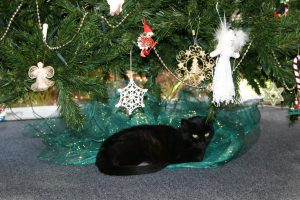Mercedes
Marla Skartvedt

Two Australian Customs and Quarantine officers stood beside me on the dock in Port Adelaide watching a third officer break the seal on the shipping container and open the doors. Inside the container, perched on the bonnet of my car was a black cat which immediately leapt to the ground and made a lightening dash for the darkest corner of the warehouse behind us. Stunned, and for a moment speechless, the four of us looked at each other wondering if we had actually seen what we thought we saw since the container had been shipped from England over 6 weeks before and clearly had not been opened. Meanwhile, a quick-thinking customs officer found a gunny sack and a ham sandwich left over from lunch and managed to entice the cat into the sack.
Australian quarantine laws are very strict. While the container had been shipped from rabies-free England, it was possible the cat might have arrived from France the day before she wandered into the container. Therefore, I was told, the cat would probably be put down immediately.
We inspected the car. It was saturated in mold: long spider webs of mold hung from the steering wheel; all surfaces were covered in powdery grey (apart from the front passenger seat which was covered in black cat hair).
I arranged to collect the car the next day. I borrowed a pair of gardening overalls and gloves to wear as protection from the mold.
At 7 a.m. the following morning, my friend from Sydney rang to say the story was on the front page of the Sydney morning paper and that although my name wasn’t mentioned, she knew the story was about me. The article said a car had arrived in Adelaide from England with a cat onboard; that the cat hadn’t eaten for over 6 weeks. There was even a map showing the route the ship had taken. The story added that quarantine officers had decided not to put the cat down–rather she would be placed in quarantine and a public meeting would be held to decide her future. The newspaper named her Mercedes.
Mercedes’ story was told in many newspapers around the world: my cousin in Alaska picked up a copy of the National Enquirer at the supermarket check-out counter and saw my photo; an old friend in Bremerton with whom I had lost touch for over 15 years saw the story and wrote to me care of one of the newspapers. My husband, in Beijing at the time, heard the story on a news broadcast.
As to Mercedes’ immediate future, the meeting organized by Quarantine officials decided Peter and I should keep the cat after her 6 months’ quarantine. The Adelaide Advertiser donated a percentage of their pet advertising revenue for Mercedes’ quarantine costs. A pet food company sponsored her food. A pet travel company donated a carry cage, collected Mercedes from quarantine and delivered her to Ansett Airlines who flew her to us in Darwin.
Mercedes lived to be 17. She was buried on our farm in a wooden coffin with an engraved brass nameplate under a headstone which read, “Mercedes, Born England 1989, stowed away to Australia 1990, Died 2006. Beloved friend of Peter and Marla.”
Media Attributions
- Photo: Mercedes © Marla Skartvedt is licensed under a All Rights Reserved license
